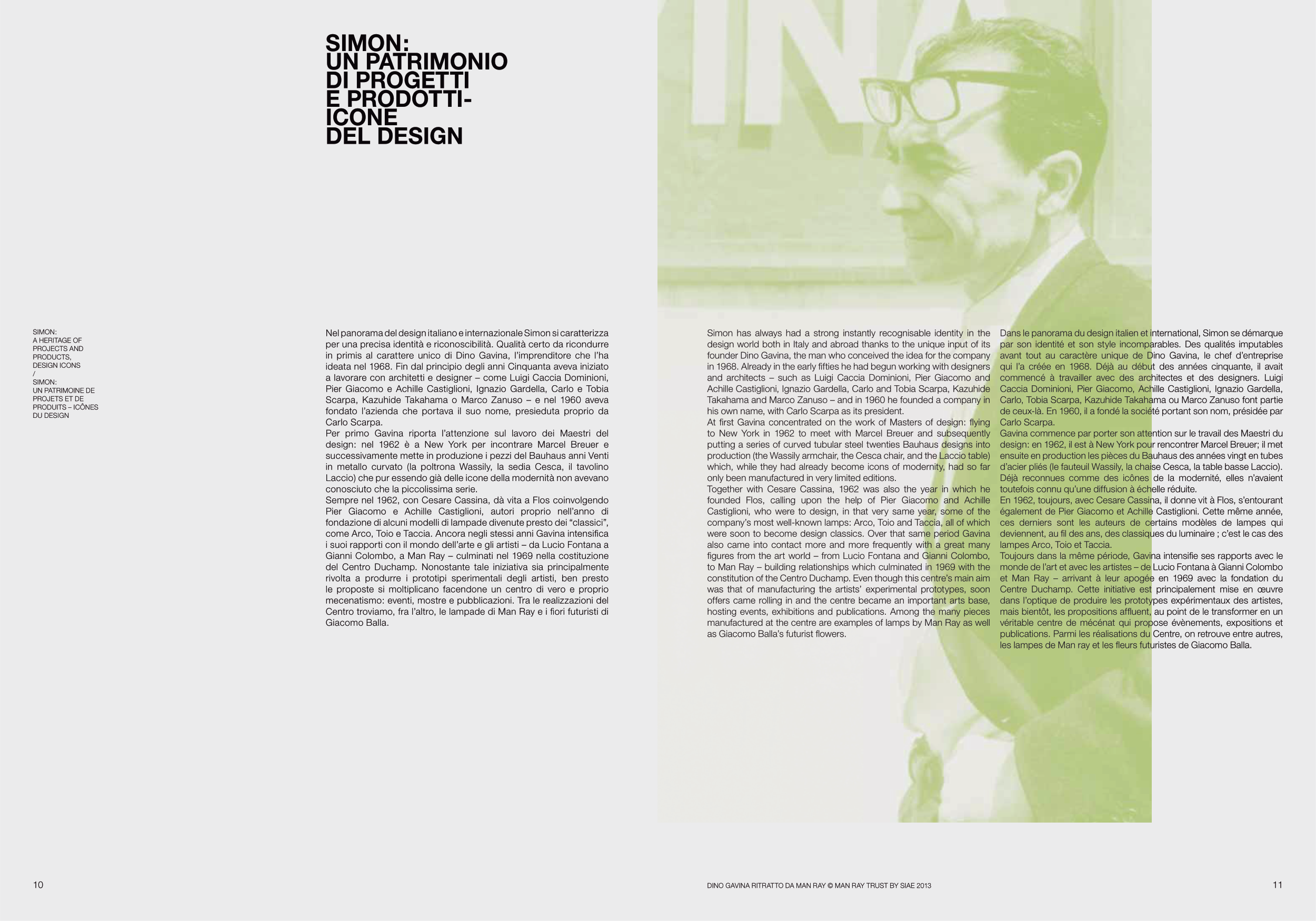Nel panorama del design italiano e internazionale Simon si caratterizza
per una precisa identità e riconoscibilità. Qualità certo da ricondurre
in primis al carattere unico di Dino Gavina, l’imprenditore che l’ha
ideata nel 1968. Fin dal principio degli anni Cinquanta aveva iniziato
a lavorare con architetti e designer – come Luigi Caccia Dominioni,
Pier Giacomo e Achille Castiglioni, Ignazio Gardella, Carlo e Tobia
Scarpa, Kazuhide Takahama o Marco Zanuso – e nel 1960 aveva
fondato l’azienda che portava il suo nome, presieduta proprio da
Carlo Scarpa.
Per primo Gavina riporta l’attenzione sul lavoro dei Maestri del
design: nel 1962 è a New York per incontrare Marcel Breuer e
successivamente mette in produzione i pezzi del Bauhaus anni Venti
in metallo curvato (la poltrona Wassily, la sedia Cesca, il tavolino
Laccio) che pur essendo già delle icone della modernità non avevano
conosciuto che la piccolissima serie.
Sempre nel 1962, con Cesare Cassina, dà vita a Flos coinvolgendo
Pier Giacomo e Achille Castiglioni, autori proprio nell’anno di
fondazione di alcuni modelli di lampade divenute presto dei “classici”,
come Arco, Toio e Taccia. Ancora negli stessi anni Gavina intensifica
i suoi rapporti con il mondo dell’arte e gli artisti – da Lucio Fontana a
Gianni Colombo, a Man Ray – culminati nel 1969 nella costituzione
del Centro Duchamp. Nonostante tale iniziativa sia principalmente
rivolta a produrre i prototipi sperimentali degli artisti, ben presto
le proposte si moltiplicano facendone un centro di vero e proprio
mecenatismo: eventi, mostre e pubblicazioni. Tra le realizzazioni del
Centro troviamo, fra l’altro, le lampade di Man Ray e i fiori futuristi di
Giacomo Balla.
Dans le panorama du design italien et international, Simon se démarque
par son identité et son style incomparables. Des qualités imputables
avant tout au caractère unique de Dino Gavina, le chef d’entreprise
qui l’a créée en 1968. Déjà au début des années cinquante, il avait
commencé à travailler avec des architectes et des designers. Luigi
Caccia Dominioni, Pier Giacomo, Achille Castiglioni, Ignazio Gardella,
Carlo, Tobia Scarpa, Kazuhide Takahama ou Marco Zanuso font partie
de ceux-là. En 1960, il a fondé la société portant son nom, présidée par
Carlo Scarpa.
Gavina commence par porter son attention sur le travail des Maestri du
design: en 1962, il est à New York pour rencontrer Marcel Breuer; il met
ensuite en production les pièces du Bauhaus des années vingt en tubes
d’acier pliés (le fauteuil Wassily, la chaise Cesca, la table basse Laccio).
Déjà reconnues comme des icônes de la modernité, elles n’avaient
toutefois connu qu’une diffusion à échelle réduite.
En 1962, toujours, avec Cesare Cassina, il donne vit à Flos, s’entourant
également de Pier Giacomo et Achille Castiglioni. Cette même année,
ces derniers sont les auteurs de certains modèles de lampes qui
deviennent, au fil des ans, des classiques du luminaire ; c’est le cas des
lampes Arco, Toio et Taccia.
Toujours dans la même période, Gavina intensifie ses rapports avec le
monde de l’art et avec les artistes – de Lucio Fontana à Gianni Colombo
et Man Ray – arrivant à leur apogée en 1969 avec la fondation du
Centre Duchamp. Cette initiative est principalement mise en œuvre
dans l’optique de produire les prototypes expérimentaux des artistes,
mais bientôt, les propositions affluent, au point de le transformer en un
véritable centre de mécénat qui propose évènements, expositions et
publications. Parmi les réalisations du Centre, on retrouve entre autres,
les lampes de Man ray et les fleurs futuristes de Giacomo Balla.
Simon has always had a strong instantly recognisable identity in the
design world both in Italy and abroad thanks to the unique input of its
founder Dino Gavina, the man who conceived the idea for the company
in 1968. Already in the early fifties he had begun working with designers
and architects – such as Luigi Caccia Dominioni, Pier Giacomo and
Achille Castiglioni, Ignazio Gardella, Carlo and Tobia Scarpa, Kazuhide
Takahama and Marco Zanuso – and in 1960 he founded a company in
his own name, with Carlo Scarpa as its president.
At first Gavina concentrated on the work of Masters of design: flying
to New York in 1962 to meet with Marcel Breuer and subsequently
putting a series of curved tubular steel twenties Bauhaus designs into
production (the Wassily armchair, the Cesca chair, and the Laccio table)
which, while they had already become icons of modernity, had so far
only been manufactured in very limited editions.
Together with Cesare Cassina, 1962 was also the year in which he
founded Flos, calling upon the help of Pier Giacomo and Achille
Castiglioni, who were to design, in that very same year, some of the
company’s most well-known lamps: Arco, Toio and Taccia, all of which
were soon to become design classics. Over that same period Gavina
also came into contact more and more frequently with a great many
figures from the art world – from Lucio Fontana and Gianni Colombo,
to Man Ray – building relationships which culminated in 1969 with the
constitution of the Centro Duchamp. Even though this centre’s main aim
was that of manufacturing the artists’ experimental prototypes, soon
offers came rolling in and the centre became an important arts base,
hosting events, exhibitions and publications. Among the many pieces
manufactured at the centre are examples of lamps by Man Ray as well
as Giacomo Balla’s futurist flowers.
DINO GAVINA RITRATTO DA MAN RAY © MAN RAY TRUST BY SIAE 2013
SIMON:
UN PATRIMONIO
DI PROGETTI
E PRODOTTI-
ICONE
DEL DESIGN
SIMON:
A HERITAGE OF
PROJECTS AND
PRODUCTS,
DESIGN ICONS
/
SIMON:
UN PATRIMOINE DE
PROJETS ET DE
PRODUITS – ICÔNES
DU DESIGN
10
11


